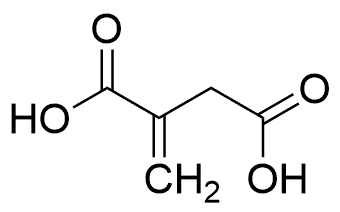Itaconic acid is widely utilized in research focused on various practical applications across multiple industries. Here are five key uses:
- Biodegradable Polymers: Itaconic acid serves as a building block for producing biodegradable plastics, making it a sustainable alternative to traditional petroleum-based plastics.
- Coatings and Adhesives: Due to its excellent adhesion properties, itaconic acid is used in formulating high-performance coatings and adhesives, enhancing durability and environmental resistance.
- Textile Industry: Itaconic acid is employed in the textile sector for producing water-repellent finishes and improving fabric strength, providing a competitive edge over similar compounds.
- Cosmetic Formulations: In cosmetics, itaconic acid acts as a stabilizer and thickener, improving the texture and performance of creams and lotions.
- Pharmaceuticals: Itaconic acid is explored in drug delivery systems, offering potential advantages in controlled release and bioavailability compared to conventional methods.
General Information
Properties
Safety and Regulations
Applications
Itaconic acid is widely utilized in research focused on various practical applications across multiple industries. Here are five key uses:
- Biodegradable Polymers: Itaconic acid serves as a building block for producing biodegradable plastics, making it a sustainable alternative to traditional petroleum-based plastics.
- Coatings and Adhesives: Due to its excellent adhesion properties, itaconic acid is used in formulating high-performance coatings and adhesives, enhancing durability and environmental resistance.
- Textile Industry: Itaconic acid is employed in the textile sector for producing water-repellent finishes and improving fabric strength, providing a competitive edge over similar compounds.
- Cosmetic Formulations: In cosmetics, itaconic acid acts as a stabilizer and thickener, improving the texture and performance of creams and lotions.
- Pharmaceuticals: Itaconic acid is explored in drug delivery systems, offering potential advantages in controlled release and bioavailability compared to conventional methods.
Documents
Safety Data Sheets (SDS)
The SDS provides comprehensive safety information on handling, storage, and disposal of the product.
Product Specification (PS)
The PS provides a comprehensive breakdown of the product’s properties, including chemical composition, physical state, purity, and storage requirements. It also details acceptable quality ranges and the product's intended applications.
Certificates of Analysis (COA)
Search for Certificates of Analysis (COA) by entering the products Lot Number. Lot and Batch Numbers can be found on a product’s label following the words ‘Lot’ or ‘Batch’.
Numéro de catalogue
Numéro de lot/série
Certificates Of Origin (COO)
This COO confirms the country where the product was manufactured, and also details the materials and components used in it and whether it is derived from natural, synthetic, or other specific sources. This certificate may be required for customs, trade, and regulatory compliance.
Numéro de catalogue
Numéro de lot/série
Safety Data Sheets (SDS)
The SDS provides comprehensive safety information on handling, storage, and disposal of the product.
DownloadProduct Specification (PS)
The PS provides a comprehensive breakdown of the product’s properties, including chemical composition, physical state, purity, and storage requirements. It also details acceptable quality ranges and the product's intended applications.
DownloadCertificates of Analysis (COA)
Search for Certificates of Analysis (COA) by entering the products Lot Number. Lot and Batch Numbers can be found on a product’s label following the words ‘Lot’ or ‘Batch’.
Numéro de catalogue
Numéro de lot/série
Certificates Of Origin (COO)
This COO confirms the country where the product was manufactured, and also details the materials and components used in it and whether it is derived from natural, synthetic, or other specific sources. This certificate may be required for customs, trade, and regulatory compliance.


